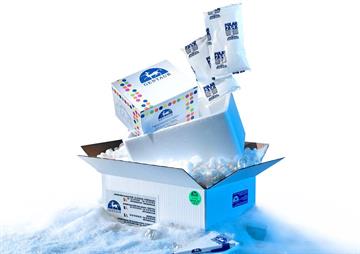Anti-Human Dkk-1 Antibody

Anti-Human Dkk-1 Antibody
748.5 EUR
In Stock
quantity
Produktdetaljer
Katalognummer: 209 - 101-M380
Produktkategori: Företag och industri > Vetenskap och laboratorium
ReliaTechGentaur
Storlek: 100 µg
Related Products
102-PA33
Anti-Human Dkk-1 Antibody
DKK-1 is a member of the DKK protein family which also includes DKK-2, DKK-3 and DKK-4. DKK-1 was originally identified as a Xenopus head forming molecule that behaves as an antagonist for Wnt signaling. Subsequent studies have shown that DKK-1 and DKK-4 play an important regulatory role in the Wnt /β-catenin signaling pathway by forming inhibitory complexes with LDL receptor-related proteins 5 and 6 (LRP5 and LRP6), which are essential components of the Wnt/βcatenin signaling system. LPR5 and LPR6 are single-pass transmembrane proteins that appear to act as co-receptors for Wnt ligands involved in the Wnt/βcatenin signaling cascade. It has been suggested that by inhibiting Wnt/β-catenin signaling, which is essential for posterior patterning in vertebrates, DKK-1 permits anterior development. This notion is supported by the finding that mice deficient of DKK-1 expression lack head formation and die during embryogenesis. Recombinant human DKK-1 fused to a C terminal His-tag derived from E. coli is a 26 kDa protein containing 235 amino-acid residues.
457.12 €
102-PA33S
Anti-Human Dkk-1 Antibody
DKK-1 is a member of the DKK protein family which also includes DKK-2, DKK-3 and DKK-4. DKK-1 was originally identified as a Xenopus head forming molecule that behaves as an antagonist for Wnt signaling. Subsequent studies have shown that DKK-1 and DKK-4 play an important regulatory role in the Wnt /β-catenin signaling pathway by forming inhibitory complexes with LDL receptor-related proteins 5 and 6 (LRP5 and LRP6), which are essential components of the Wnt/βcatenin signaling system. LPR5 and LPR6 are single-pass transmembrane proteins that appear to act as co-receptors for Wnt ligands involved in the Wnt/βcatenin signaling cascade. It has been suggested that by inhibiting Wnt/β-catenin signaling, which is essential for posterior patterning in vertebrates, DKK-1 permits anterior development. This notion is supported by the finding that mice deficient of DKK-1 expression lack head formation and die during embryogenesis. Recombinant human DKK-1 fused to a C terminal His-tag derived from E. coli is a 26 kDa protein containing 235 amino-acid residues.
339 €
101-M380
Anti-Human Dkk-1 Antibody
Dkk1 is a Dickkopf-related protein that inhibits Wnt signaling by binding the Wnt coreceptor LRP5/6. It also binds Kremen1 and Kremen2. Dkk1 is important in embryonic development.
748.5 €
102-P28
Anti-Human IGF-1 Antibody
Insulin-like growth factor (IGF)-I (also known as somatomedin C and somatomedin A) and IGF-II (multiplication stimulating activity or MSA) belong to the family of insulin-like growth factors that are structurally homologous to proinsulin. Mature IGF-I and IGF-II share approximately 70% sequence identity. Both IGF-I and IGF-II are expressed in many tissues and cell types and may have autocrine, paracrine and endocrine functions. Mature IGF-I and IGF-II are highly conserved between the human, bovine and porcine proteins (100% identity), and exhibit cross-species activity.
518.55 €
102-PA138
Anti-Human Mdg-1 Antibody
Angiogenesis research has focused on receptors and ligands mediating endothelial cell proliferation and migration. Little is known about the molecular mechanisms that are involved in converting endothelial cells from a proliferative to a differentiated state. Microvascular differentiation gene 1 (Mdg1) has been isolated from differentiating microvascular endothelial cells that had been cultured in collagen type I gels (3D culture). In adult human tissue Mdg1 is expressed in endothelial and epithelial cells. Sequence analysis of the full-length cDNA revealed that the N-terminal region of the putative Mdg1-protein exhibits a high sequence similarity to the J-domain of Hsp40 chaperones. It was shown that this region functions as a bona fide J-domain as it can replace the J-domain of Escherichia coli DnaJ-protein. Mdg1 is also upregulated in primary endothelial and mesangial cells when subjected to various stress stimuli. GFP–Mdg1 fusion constructs showed the Mdg1-protein to be localized within the cytoplasm under control conditions. Stress induces the translocation of Mdg1 into the nucleus, where it accumulates in nucleoli. Costaining with Hdj1, Hdj2, Hsp70, and Hsc70 revealed that Mdg1 colocalizes with Hsp70 and Hdj1 in control and stressed HeLa cells. These data suggest that Mdg1 is involved in the control of cell cycle arrest taking place during terminal cell differentiation and under stress conditions.
457.12 €
102-PA138S
Anti-Human Mdg-1 Antibody
Angiogenesis research has focused on receptors and ligands mediating endothelial cell proliferation and migration. Little is known about the molecular mechanisms that are involved in converting endothelial cells from a proliferative to a differentiated state. Microvascular differentiation gene 1 (Mdg1) has been isolated from differentiating microvascular endothelial cells that had been cultured in collagen type I gels (3D culture). In adult human tissue Mdg1 is expressed in endothelial and epithelial cells. Sequence analysis of the full-length cDNA revealed that the N-terminal region of the putative Mdg1-protein exhibits a high sequence similarity to the J-domain of Hsp40 chaperones. It was shown that this region functions as a bona fide J-domain as it can replace the J-domain of Escherichia coli DnaJ-protein. Mdg1 is also upregulated in primary endothelial and mesangial cells when subjected to various stress stimuli. GFP–Mdg1 fusion constructs showed the Mdg1-protein to be localized within the cytoplasm under control conditions. Stress induces the translocation of Mdg1 into the nucleus, where it accumulates in nucleoli. Costaining with Hdj1, Hdj2, Hsp70, and Hsc70 revealed that Mdg1 colocalizes with Hsp70 and Hdj1 in control and stressed HeLa cells. These data suggest that Mdg1 is involved in the control of cell cycle arrest taking place during terminal cell differentiation and under stress conditions.
339 €
Håll dig uppdaterad! Visa tidigare publikationer

By: Author , 2 Comment
Anaplasmos hos hundar och katter – allt du behöver veta
23 August 2025

By: Author , 2 Comment
Solbränna – hur leker man säkert i solen?
16 August 2025

By: Author , 2 Comment
Biologiska läkemedel – Modernitet inom farmaci
1 August 2025

By: Author , 2 Comment
Icke-steroida antiinflammatoriska läkemedel – viktig information om populära läkemedel
22 July 2025








